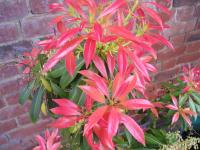Flames of Spring: Pieris 'Forest Flame'
 The young leaves of Pieris 'Forest Flame' are one of its best features
The young leaves of Pieris 'Forest Flame' are one of its best featuresThe vivid young leaves of Pieris 'Forest Flame' can ignite even the chilliest of spring days.
Winter evenings armchair bound in front of a roaring fire may be a distant memory, but we are reminded of those cosy occasions by an evergreen shrub called Pieris 'Forest Flame'. The bright young scarlet leaves of Pieris 'Forest Flame' rival any spring flower for their intensity of colour and beauty.
Vivid Foliage
In my opinion, it is the young leaves of Pieris 'Forest Flame' that are it's number one feature. The juvenile foliage is about as red as red can be and catches your eye from a distance, drawing you to it's intensity and richness. With age, the leaves change, becoming leathery and glossy and dark green in colour, having changed through shades of pink, cream and red from the initial scarlet intensity.
Pieris 'Forest Flame' produces sprays of creamy-white urn-shaped flowers in mid-late spring.
The Pieris Genus is a classic example of how plants are grouped, classified and organised into different families, according to their flower shape and structure. If you look at the Heaths and Heathers (Calluna and Erica) you would struggle to find any similarity between them and Pieris; the leaves are very different and flower colour is rarely the same.
But on closer examination, you will see that there is a definite similarity between the flower shape and structure of Calluna, Erica and Pieris. That is why they are grouped together in the same family; Ericaceae.
Pieris species are native to China, Japan and the Himalaya region. Pieris 'Forest Flame' is thought to be a cross between Pieris japonica and P. formosa, the former obviously being native of Japan, but also found growing wild in Taiwan and Eastern China. P.formosa is native to the Himalaya region and China.
Growing Conditions
Grown in ideal conditions, Pieris 'Forest Flame' may grow up to 3 m x 3 m.
By ideal conditions I mean a sheltered, semi-shady location. Although reliably hardy, if late spring frosts are forecast when the delicate young scarlet shoots are developing it may be a good idea to cover the plant at night with some protective fleece. The site should also offer some protection from strong, cold winds.
If planting in the garden, it should be acidic soil (with a pH value lower than 7) nutritious, and moist but well drained. Watering should be done using rainwater because mains water often contains too much lime for ericaceous plants.
From time to time, when working in client's gardens I find Pieris 'Forest Flame' planted in ordinary garden soil that is really not suitable, the plant often looks poorly and in need of a rescue mission. I usually suggest that I carefully dig up the plant and pot it up in a suitable container of ericaceous compost and relocate it to a more suitable site within the garden.
Pieris 'Forest Flame' should always be included in any planting plan for a raised bed or border of ericaceous plants. Pieris 'Forest Flame' is often forgotten when planning a dedicated scheme for plants like rhododendrons, Camellias and Azaleas. These plants are prized for their spectacular floral displays but Pieris 'Forest Flame' offers double value with the contrast between the foliage colours produced and the spring flowers.
For more information about Pieris 'Forest Flame' visit our Plant Database.
Filed under Shrubs.
